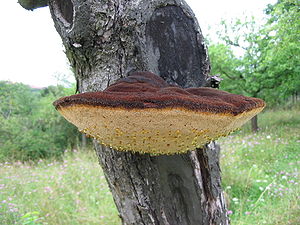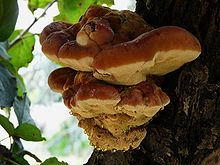Shaggy Schillerporling
| Shaggy Schillerporling | ||||||||||||
|---|---|---|---|---|---|---|---|---|---|---|---|---|

Shaggy Schillerporling ( Inonotus hispidus ) |
||||||||||||
| Systematics | ||||||||||||
|
||||||||||||
| Scientific name | ||||||||||||
| Inonotus hispidus | ||||||||||||
| ( Bull. ) P. Karst. |
The Shaggy Schillerporling ( Inonotus hispidus ), also called " Plüschporling called," a fungal art from the family of the bristle disc relatives (Hymenochaetaceae).
features
The shaggy Schillerporling forms console-shaped, single or several roof-tile-like fruiting bodies with a width of 10 to 30 cm and a thickness of 3 to 10 cm. Fresh specimens are spongy, heavy and rusty brown in color, bruises turn dark brown-black. The unzoned top has a velvety, plush-like to coarsely shaggy structure. The pores are 2–3 per mm, have a yellow to rust brown color and always excrete guttation drops in the phase of intensive growth . The tubes are 2–5 cm long and, like the Trama, are golden to rust-brown in color. In the winter half-year, the “annual” fruiting bodies can be seen as black remains on the tree.
Ecology and phenology
The shaggy Schillerporling is a parasitic wood dweller and causes massive white rot in deciduous trees, especially ash and apple , as well as real walnut , whitebeam trees and often in plane trees , rarely in Japanese pagoda trees . It favors characterized gouging of nests for the hole breeders among birds and the application of the Nistgänge the carpenter bees . The species occurs absent-mindedly or rarely in natural deciduous forests, but more often the mycelium of this large porling lives and proliferates in older orchard, park and street trees, in gardens and similar habitats. The shaggy Schillerporling usually fructifies from the trunk wounds of living or freshly dead, still standing trees.
The fruiting bodies of the shaggy Schillerporling appear in Central Europe mostly from early summer to autumn, and in other seasons when the weather is good.
distribution
The shaggy Schillerporling occurs from the northern subtropical to the temperate latitudes, it occurs in Asia from Syria, Turkey and Iran via India to China and Japan, in South and North America (Venezuela, Mexico, USA), North Africa, Australia and Tasmania, the Canary Islands and Europe. In Europe, its distribution area extends from the Mediterranean to England and the North and Baltic Seas, eastward to Romania, Ukraine and Belarus. The species does not occur in the Baltic States, there are individual occurrences in Scandinavia as well as in southern and central Russia.
meaning
The shaggy Schillerporling is out of the question as an edible mushroom due to its cork-like consistency. As a trunk parasite, it can severely damage fruit, street and park trees.
swell
literature
- German Josef Krieglsteiner (Ed.): The large mushrooms of Baden-Württemberg . Volume 1: General Part. Stand mushrooms: jelly, bark, prick and pore mushrooms. Ulmer, Stuttgart 2000, ISBN 3-8001-3528-0 .
- Schwarze / Engels / Matteck: "Holzzersetzende Pilze in Trees", 1st edition 1999, Rombach Verlag, ISBN 3-7930-9194-5 , pp. 95-102
Individual evidence
- ↑ http://tintling.com/inhalt/1998/Grossporlinge_2.pdf
- ↑ TW May, J. Milne, S. Shingles, RH Jones: Fungi of Australia. Catalog and Bibliography of Australian Fungi 2. Basidiomycota pp & Myxomycota pp CSIRO Publishing. 2003. ISBN 978-0643069077 .
- ↑ Anna JM Hopkins: The taxonomy and ecology of wood decay fungi in Eucalyptus obliqua trees and logs in the wet sclerophyll forests of southern Tasmania ( Memento of September 7, 2012 in the Internet Archive ). PhD thesis, University of Tasmania. (PDF; 3.98 MB)


